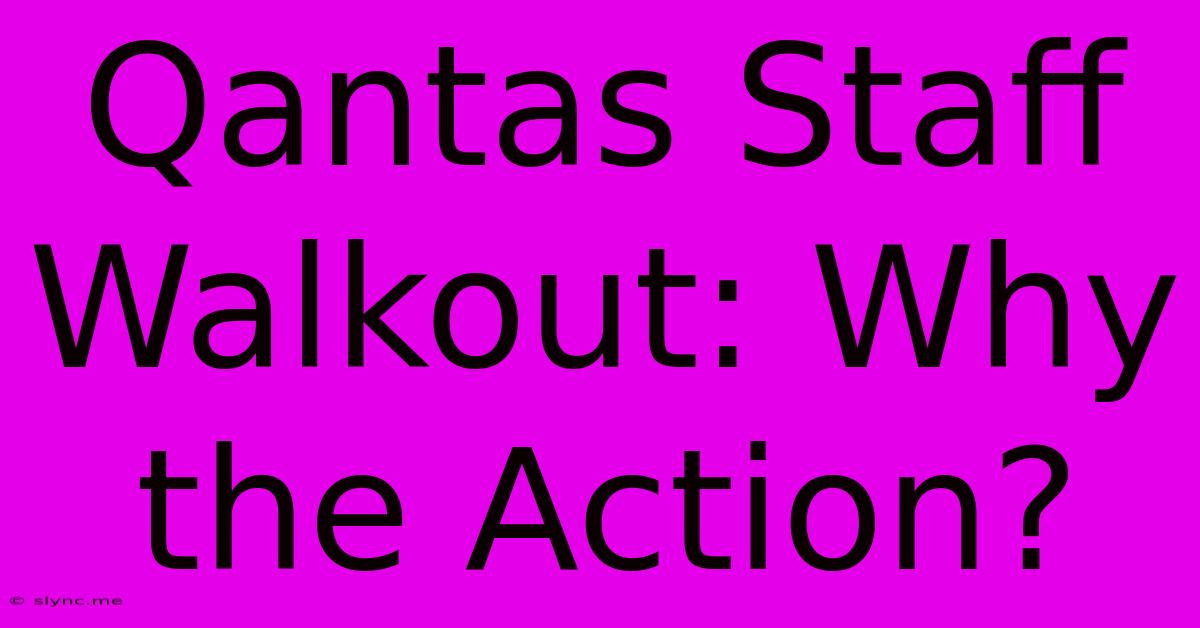Qantas Staff Walkout: Why The Action?

Discover more detailed and exciting information on our website. Click the link below to start your adventure: Visit Best Website Mrs.Amykhan. Don't miss out!
Table of Contents
Qantas Staff Walkout: Unpacking the Reasons Behind the Action
The recent Qantas staff walkout has sent ripples through the Australian aviation industry and beyond. This significant industrial action, involving various Qantas staff groups, isn't simply a spontaneous outburst; it's the culmination of simmering discontent and unresolved issues. Understanding the reasons behind this walkout requires examining the complex interplay of factors affecting employee relations within the airline.
Key Grievances Fueling the Qantas Staff Walkout
The walkout isn't driven by a single cause, but rather a confluence of concerns. These include:
1. Job Security and Employment Conditions:
Many Qantas employees feel their job security is precarious. Concerns regarding outsourcing, contracting, and the potential for further job losses have fueled anxieties. The perceived erosion of employment conditions, including pay and benefits, further exacerbates these anxieties. Employees feel their contributions aren't adequately reflected in their compensation and working conditions, especially considering the airline's profitability.
2. Pay and Wages:
A significant point of contention is the perceived inadequacy of wages and benefits. Inflationary pressures have eroded the real value of salaries, leading employees to feel their compensation isn't keeping pace with the rising cost of living. The disparity between executive compensation and employee wages also adds fuel to the fire, sparking resentment and feelings of unfairness.
3. Working Conditions:
Beyond compensation, the actual working conditions are another area of concern. Many employees report excessive workloads, inadequate staffing levels, and a lack of support from management. This can lead to burnout, stress, and a generally negative working environment. These conditions impact not only employee well-being but also the quality of service provided to passengers.
4. Lack of Communication and Consultation:
A significant complaint among striking workers is the perceived lack of effective communication and meaningful consultation from Qantas management. Employees feel their concerns and suggestions are not adequately considered, leading to a sense of alienation and powerlessness. This breakdown in communication further fuels the sense of mistrust between management and staff.
The Broader Context: Qantas's Post-Pandemic Recovery
The Qantas staff walkout also needs to be understood within the context of the airline's post-pandemic recovery. While Qantas has reported significant profits after the pandemic disruptions, some argue these profits haven't been fairly shared with employees who bore the brunt of the pandemic's impact, including pay cuts and job losses. The walkout, therefore, can be interpreted as a fight for a fairer share of the airline's success.
The Impact of the Qantas Staff Walkout
The walkout has had a significant impact, causing widespread disruption to travel plans and considerable financial losses for Qantas. Furthermore, it damages the airline's reputation and erodes public trust. The long-term implications for employee-employer relations at Qantas remain to be seen.
Potential Solutions and Future Outlook
Resolving the issues requires open and honest dialogue between Qantas management and its employees. This includes addressing concerns regarding job security, improving compensation and working conditions, enhancing communication channels, and fostering a more collaborative work environment. Effective negotiation and compromise are crucial to prevent further industrial action and rebuild trust. The future success of Qantas depends heavily on fostering a healthy and productive relationship between management and its workforce.
Keywords: Qantas staff walkout, Qantas strike, airline strike, industrial action, Qantas employees, job security, wages, working conditions, employee relations, aviation industry, Australia, post-pandemic recovery, labor dispute.

Thank you for visiting our website wich cover about Qantas Staff Walkout: Why The Action?. We hope the information provided has been useful to you. Feel free to contact us if you have any questions or need further assistance. See you next time and dont miss to bookmark.
Also read the following articles
| Article Title | Date |
|---|---|
| Witness The Geminids Over Australia | Dec 13, 2024 |
| Erin Molans Statement Sky 2 Day Fm Axing | Dec 13, 2024 |
| Rosiya Atakuye Ukrayinu Shakhedami | Dec 13, 2024 |
| Povitryana Trivoga Raketni Udari Po Ukrayini | Dec 13, 2024 |
| Sms Vid Brama Bezpeka Ta Priznachennya | Dec 13, 2024 |
